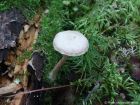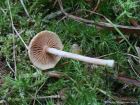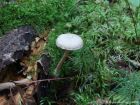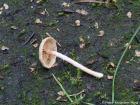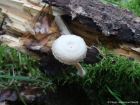Cap at first it is hemispherical, then it becomes convex, later flattening out and remaining umbonate with age. The colour ranges from cream-brown to light brown, brown, orange-brown, reddish-brown, and grey-brown. When dry it is much paler, whitish with a reddish sheen. Even when young it is entirely covered with white, scaly remnants of the veil. In wet weather it becomes translucently striate up to the middle. The skin extends beyond the margin and is fringed. Gills distant and much the same colour as the cap, adnate or slightly decurrent. Stem cylindrical, becoming smooth with age. It is whitish-grey to light brown, fibrous-scaly, and very coarse. Towards the base it is darker grey to brown, with a white velvety covering from the mycelium. Occasionally it has a white scaly ring zone. Spore print ochre brown.
Microscopic Features: Spores are ellipsoidal, smooth, and measure 7–10 × 4–6 µm.
Tubaria conspersa on the First Nature Web site.
Many mushrooms are poisonous, and some can be lethally toxic. Distinguishing between edible and poisonous mushrooms can be very challenging. Therefore, we strongly advise against consuming wild mushrooms. This website does not contain any information about the edibility or toxicity of mushrooms.
Although efforts have been made to ensure accuracy on this website, the information may contain errors and omissions. Therefore, all content provided is for educational and informational purposes only and should not be relied upon or used as a basis for consuming any plants or mushrooms.
External links are provided for reference only. We do not endorse or take responsibility for the content, advice, or products found on these sites or in any advertisements shown on this website.
